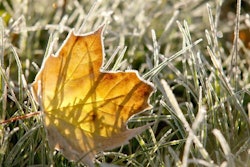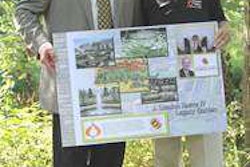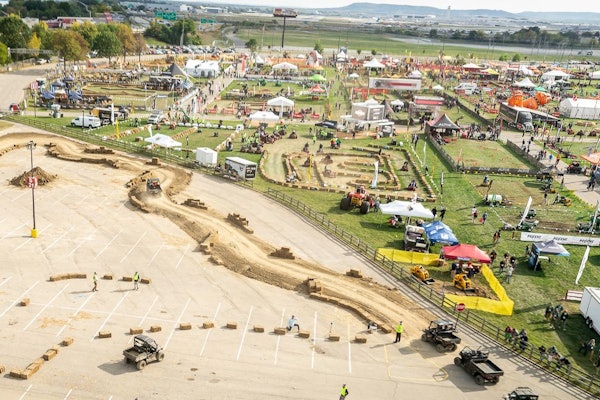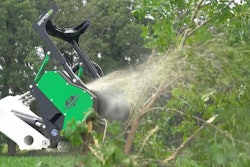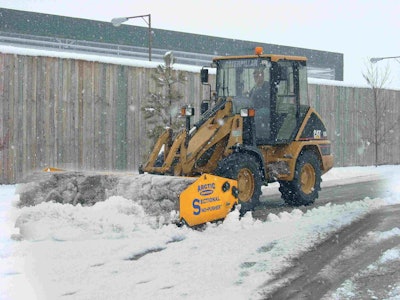 Selecting the right pusher positively impacts the life of the machine powering it, whether it’s a small skid steer or large loader.
Selecting the right pusher positively impacts the life of the machine powering it, whether it’s a small skid steer or large loader.Photo: Arctic Snow & Ice Products
As the days shorten and the temperatures drop, snowy and icy weather can’t be far behind. When preparing for the long months ahead, snow and ice removal service providers can avoid the winter blues and keep their budgets out of the red by choosing the right pusher with the most beneficial features for their business needs.
Having the proper snow pusher can make or break a snow and ice management operation. The right pusher will move large amounts of snow and increase operator productivity – not to mention enhance safety and reduce repair expenses, in turn cutting costly downtime.
Selecting the right pusher positively impacts the life of the machine powering it, whether it’s a small skid steer or large loader.
With so many options, from different moldboard and hitch designs to cutting blades and side panels, the decision can be overwhelming, especially for a newbie to the industry. In order to make the best possible decision, snow removal service providers should take the time to consider how each feature contributes to an improved bottom line to guarantee they receive the best value.
Sizing up the situation
Many contractors, whether first-time buyers or experienced snow removal professionals, get hung up on one thing: size. Some think the biggest, most expensive pusher is the answer. Others look for the smallest, cheapest pusher. However, there’s more to consider than the matter of size. Snow pushers come in a variety of styles and sizes, and offer numerous advancements and features designed to maximize efficiency and profits.
Equipment-mounted pushers, commonly called containment plows or box plows, typically range from 6 feet for smaller machines, such as skid steers, up to 30 feet for larger equipment, such as wheel loaders.
Pusher size primarily affects the amount of snow removed and with what precision. Long, one- piece containment plows will move large quantities of snow the first time, but will leave behind a significant amount as they ride on the highest ground.
No pavement, whether a road or parking lot, is completely flat and level. Roads tend to be higher in the center and gradually slope downward on each side, while parking lots have both raised and depressed areas scattered throughout. A longer snow pusher will always rest at the highest point on a surface and float over lower areas, leaving behind inches of snow for follow-up pushing, usually from a pick-up operator with a smaller pusher.
Businesses have to make the choice whether to add their own pick-up operator to the staff – increasing labor, equipment and fuel costs – or sub-contract that work. With leftover snow, salting is more likely to be needed, adding another time-consuming process and extra expense.
Compared with a long snow pusher, a short snow pusher is more concentrated and precise. Operators can target an area and clear more snow with fewer follow-ups. Ideally suited for common, smaller pieces of equipment in a fleet, short pushers attach easily to skid steers and compact loaders.
Small pushers offer many advantages, yet due to their small size require more total passes to remove the same amount of snow as large pushers. Outsourcing or adding a pick-up plow to handle follow-ups might be necessary, as short snow pushers will still miss small areas like dips in roads or parking lots. Plus, some degree of salting will be required.
Stronger together: sectional pushers
Sometimes contractors face the important decision between the sheer volume of snow cleared or precision. But there’s an option for those who want the best of both worlds. To offer the benefit of moving large amounts of snow with superb precision and less follow-up than conventional pushers, some pusher manufacturers tweaked moldboard designs and developed sectional configurations.
Sectional moldboards consist of several pieces that, together, form one large surface area, enabling large amounts of snow to be removed in a single pass. These unique sectional styles provide precise, efficient snow and ice removal.
Just about every snow pusher on the market offers a trip edge. As the edge encounters an obstacle, the pusher “trips” or lifts slightly, to clear the object without damaging the pusher. With some pushers, the entire unit lifts and misses a whole pile of snow, requiring additional passes to fully remove. Sectional moldboard pushers offer the same concept, but on an individual basis. Rather than the whole pusher width tripping, only the individual section encountering an obstacle trips, leaving virtually no snow behind and eliminating the need for extra passes. Pushing a clean lot the first time not only reduces fuel and labor costs but also eliminates liability issues and costs resulting from slip and fall claims.
The independent movement of each section provides efficiency and precision by essentially letting the entire pusher contour to any given surface. On sloped roads and parking lots, the outer pieces rest at lower points, while those toward the center rise up as the pavement does. As the snow pusher approaches a depressed or elevated area, the section responds to the change in elevation and adjusts itself accordingly. This ensures virtually no snow is left behind and essentially eliminates the need for a pick-up mounted plow or salting.
Fixed vs. mechanical side panels
In addition to providing better clearing performance than conventional pushers and plows, the individual tripping action prevents damage to the pusher and machine when encountering a small obstacle. When large, rigid objects, such as curbs, hide under the snow, consider a pusher with mechanical side panels.
Most containment-style plows include side panels, or wings, attached to both ends of the moldboard. These panels keep snow contained, eliminating excess amounts of snow rolling off the sides. But sometimes, fixed side panels can pose major challenges.
Imagine a loader pushing full speed on a city street using a model with fixed side panels. Deep snow blows across both lanes, so much so that the driver can’t see a concrete median on his left side. When he eventually hits it, something is going to absorb the impact – the pusher, the machine or the operator. The last thing any business owner wants is serious injury to an employee, not to mention the worker’s compensation costs that go along with it. And in the most extreme cases, the machine’s cab ejects the operator upon such harsh impact. Because of safety concerns, some manufactures offer pushers with mechanical side panels.
Mechanical side panels respond to the impact from major obstructions, such as curbs, medians and manhole covers. Rather than hit these objects head-on, the side panels lift up and go over, clearing even tall obstacles. Offering a three-fold benefit, mechanical side panels reduce damage to the equipment, protect the pusher and, most importantly, keep the operator safe.
Beyond operator safety, buried obstructions pose other hazards to snow removal operations. Since the impact must be absorbed, the machine might receive damage – enough damage to put a large, expensive piece of equipment, such as a skid steer, loader or backhoe out of commission. Mechanical side panels minimize the chance of equipment damage, saving on related expenses and downtime. A well-maintained snow pusher with mechanical side panels can also last several years even with inexperienced operators, positively impacting ROI.
Quick with the hitch
With safety features as a top priority, manufactures also design other pusher features with the operator in mind. New hitch designs, for instance, reduce stress on operators, who lift and drop pushers hundreds of times through a shift. Typically, the operator manually adjusts the pusher each time it drops. Leading to a time-consuming, challenging and – for inexperienced operators – frustrating process that can result in extra maintenance and repairs if done incorrectly.
New drop-and-go hitch designs do the lifting and lowering automatically. The operator can just drop the pusher and go. The hitch design ensures the pusher will lie correctly each and every time, extending the pusher’s life and guaranteeing a clean surface even with inexperienced operators.
Beyond operator ease, these hitches let the pusher and machine move independently. For example, as the pusher leads the way through a parking lot, it will reach a raised point in the unleveled pavement before the machine does. Normally in this situation, the pusher rests itself on the higher ground and leans slightly forward. That lifts the machine up off its front wheels, creating inefficient drag while putting weight on only two tires.
Over time, this movement results in uneven tire wear and frequent replacements. This action also puts the majority of weight and stress on the pusher, making premature wear inevitable.
With newer hitches, the pusher lifts up and adjusts to the pavement, while the machine stays balanced on all four tires, keeping even wear on the tires and the pusher. Especially when combined with sectional moldboard styles, this movement further lets the pusher continuously adjust to changes in the pavement for optimum pushing efficiency while reducing the need for follow-up pushing.
These types of hitch designs prevent premature wear on the pusher’s shoes, as well. Commonly made of steel, pusher shoes survive through several years of abuse. But premature wear drastically cuts short their lifespan, a common occurrence with conventional hitch designs that require manual adjustment. “Drop-and-go” styles lay flat and ensure the shoes do as well, leading to even wear and less replacement, hassle and headaches for the operator.
Making the cut
Working together, these features significantly enhance performance and minimize maintenance expense, but one more factor and wear item plays a significant role: The pusher cutting edge affects not only performance of the machine but also the total lifecycle cost of the pusher.
Every pusher has a cutting edge. Designed to scrape and clean away compacted snow and ice, cutting edges add the all-important finishing touch and further reduce the need for extra pushing and salting.
Ideal for cutting through and scraping snow and ice, steel cutting edges prove to be more effective and durable than rubber options. On the downside, replacing steel edges can be significantly more expensive, but that shouldn’t necessarily be a deterrent. In combination with sectional moldboards, steel cutting edges are not only effective but can be replaced in 24- to 32- inch sections rather than the entire length of the pusher. This significantly reduces repair costs while providing all the benefits of the steel edge.
Before the full force of winter snow and ice hits, contractors should take time to evaluate their equipment fleet. It’s more than a matter of prepping for the season. Choosing the best pusher with the right features can make the difference in overall efficiency, productivity and safety. Plus, selecting the right pusher will maximize profits and turn winter blues into some serious winter green.
EDITOR’S NOTE: This article was contributed by Randy Strait, president of Arctic Snow & Ice Products, the manufacturing division of Arctic Snow and Ice Control Inc. of Bradley, Illinois.


